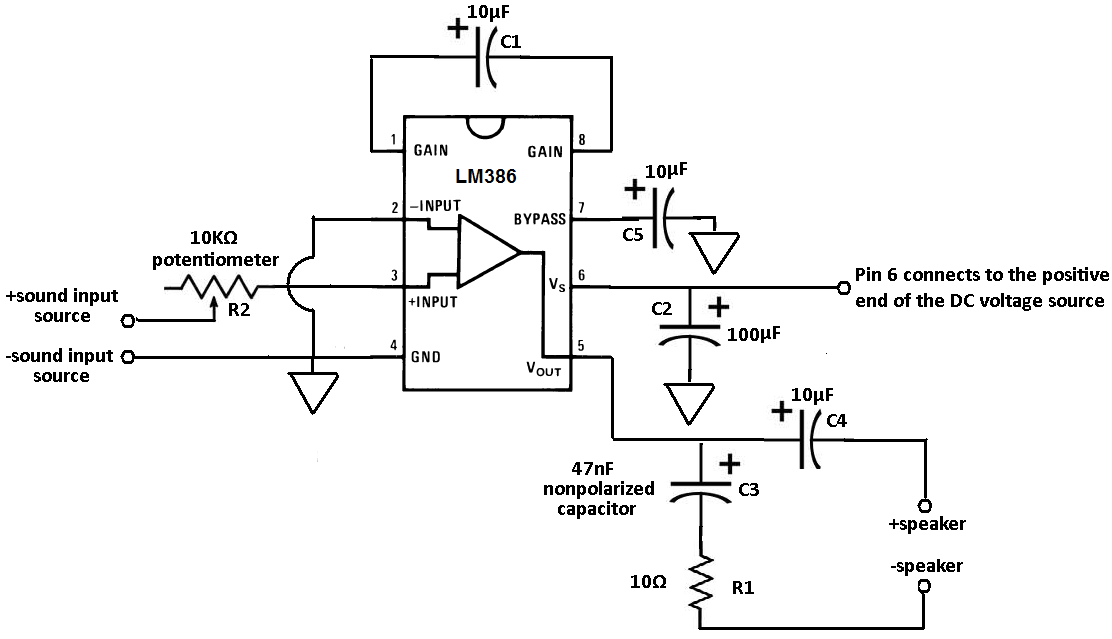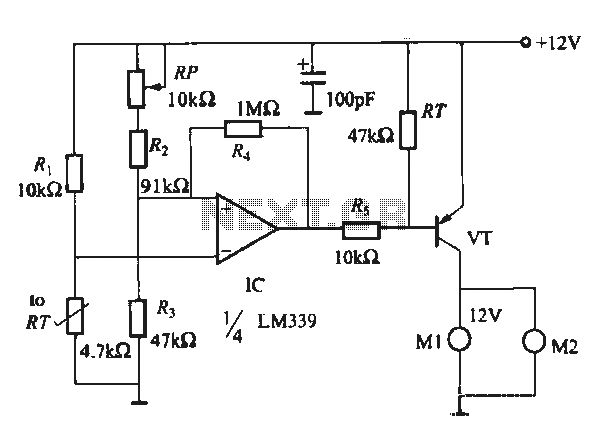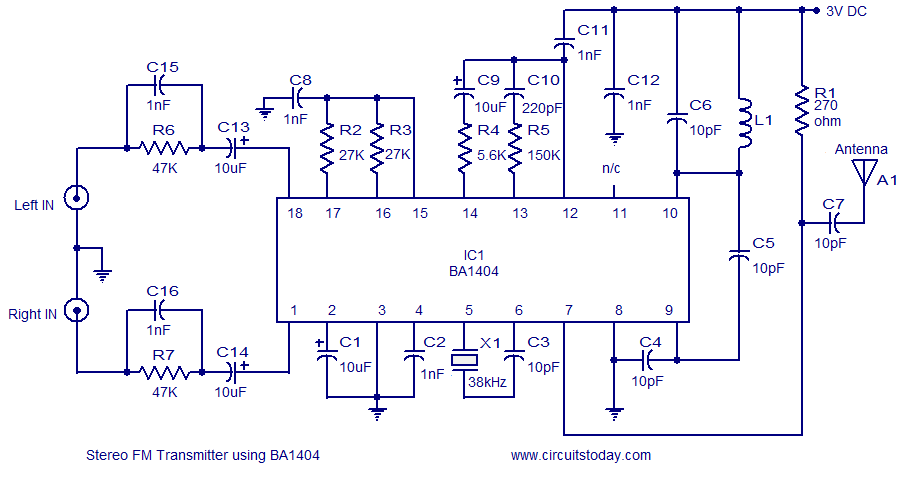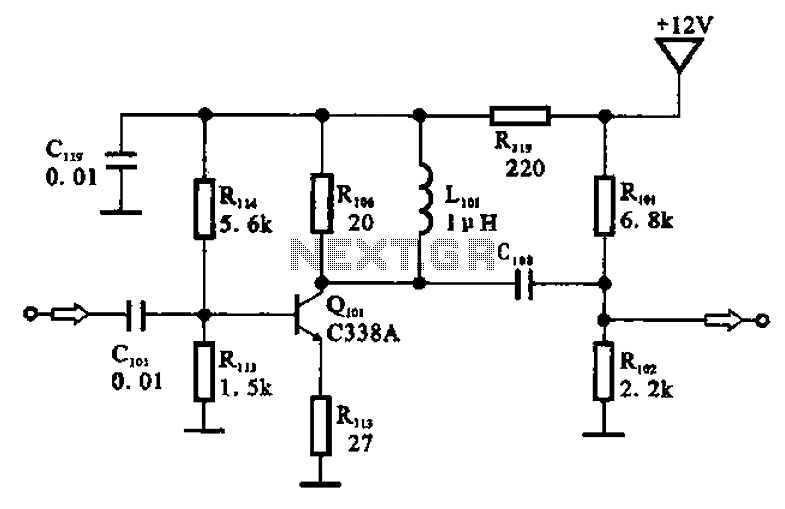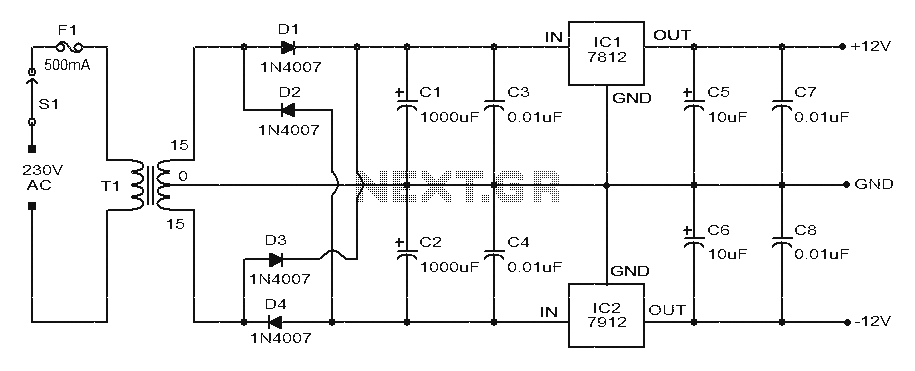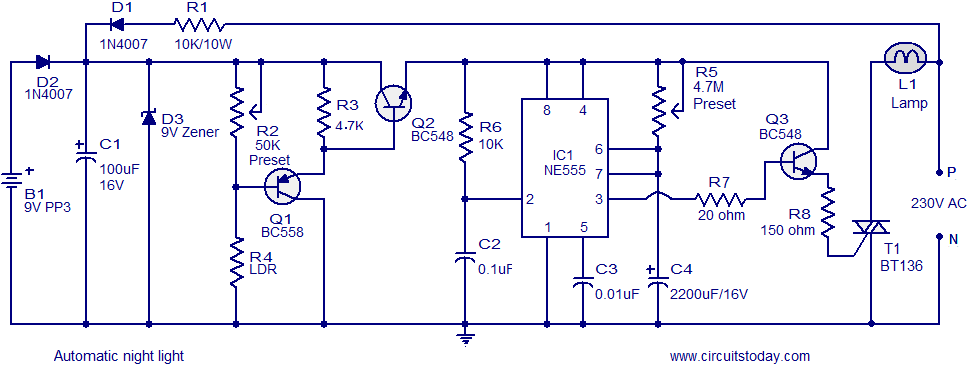
Single Chip FM Transmitter Circuit
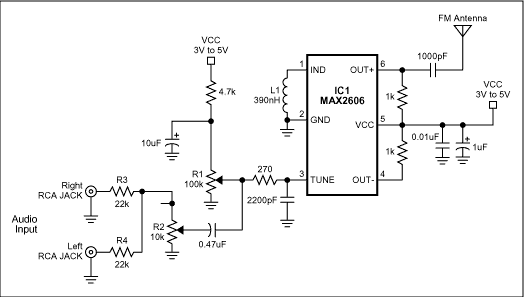
A simple FM transmitter connects a home entertainment system to a portable radio that can be moved around the house and into the backyard. For instance, music can be played from a CD player in the living room and listened to on a portable radio during a backyard barbecue. IC1 serves as a voltage-controlled oscillator with a chip varactor. Its nominal frequency is determined by inductor L1, with a value of 390nH setting the frequency at 100MHz. Potentiometer R1 allows for tuning across the FM band from 88MHz to 108MHz. The output power is approximately -21dBm into 50 ohms (most countries have emission limits below 10dBm in the FM band). The left and right audio signals from the home system are combined by resistors R3 and R4 and can be attenuated by the optional potentiometer R2. The wiper signal from R2 acts as a volume control by modulating the RF frequency. Signals above 60mV introduce distortion, so the potentiometer is used to reduce the signal below this level. In the absence of a standard FM radio antenna, a 75cm (30 inches) length of wire can serve as a transmitting antenna. For optimal reception, it should be positioned alongside the receiving antenna. The integrated circuit operates on a single supply voltage ranging from 3V to 5V, and it is advisable to adjust the supply voltage to minimize frequency drift and noise.
The FM transmitter circuit is designed to facilitate wireless audio transmission from a home entertainment system to a portable radio receiver. The core component of this circuit is the integrated circuit (IC1), which functions as a voltage-controlled oscillator (VCO). This VCO utilizes a varactor diode to control its oscillation frequency, which is primarily determined by the inductance of inductor L1. The specified value of 390nH for L1 sets the oscillator's nominal frequency to 100MHz, a frequency within the FM band.
To enable user-friendly tuning, potentiometer R1 is incorporated into the circuit. This component allows the user to select any frequency within the FM band, specifically between 88MHz and 108MHz, by adjusting the resistance. This feature is crucial for avoiding interference with other FM broadcasts and ensuring clear audio transmission.
The output stage of the transmitter provides a power level of approximately -21dBm into a 50-ohm load. This output level is compliant with regulatory standards in many countries, which typically restrict emissions to below 10dBm in the FM band. The audio signals from the home entertainment system are processed through resistors R3 and R4, which combine the left and right audio channels. The optional potentiometer R2 serves to attenuate the combined audio signal, allowing the user to modulate the RF frequency effectively. The wiper of R2 provides a variable control signal that adjusts the amplitude of the audio input, ensuring that it remains below the distortion threshold of 60mV.
In terms of antenna design, a simple 75cm wire can be used as a transmitting antenna in the absence of a dedicated FM antenna. For optimal performance, this wire should be positioned in close proximity to the receiving antenna, enhancing the overall reception quality.
The power supply for the circuit is designed to operate within a range of 3V to 5V. Proper regulation of this supply voltage is essential, as it helps to minimize frequency drift and noise, which can adversely affect the quality of the transmitted audio signal. Overall, this FM transmitter circuit represents a practical solution for wireless audio distribution in a home environment.A simple FM transmitter links your home-entertainment arrangement to a carriageable radio that can be agitated about the abode and into the aback yard. For example, you can comedy music on the CD banker in your active room, and acquire to it on a carriageable radio by the back-yard barbeque.
IC1 is a voltage-controlled oscillator with chip varacto r. Its nominal abundance of cadence is set by inductor L1, and a 390nH amount places that abundance at 100MHz. Potentiometer R1 again lets you baddest a approach by affability over the FM bandage of 88MHz to 108MHz.
Output ability is about -21dBm into 50 (most countries acquire emissions beneath 10dBm in the FM band). The home system`s larboard and appropriate audio signals are summed by R3 and R4, and attenuated by the (optional) potentiometer R2.
R2`s wiper arresting serves as a aggregate ascendancy by modulating the RF frequency. Signals aloft 60mV acquaint distortion, so the pot attenuates bottomward from that level. In the absence of a accepted FM radio antenna, 75cm (30 inches) of wire will answer as a transmitting antenna. For best reception, it should be army alongside with the accepting antenna. The IC operates on a distinct accumulation voltage in the ambit 3V to 5V, but you should adapt the activated voltage to abbreviate abundance alluvion and noise.
🔗 External reference
The FM transmitter circuit is designed to facilitate wireless audio transmission from a home entertainment system to a portable radio receiver. The core component of this circuit is the integrated circuit (IC1), which functions as a voltage-controlled oscillator (VCO). This VCO utilizes a varactor diode to control its oscillation frequency, which is primarily determined by the inductance of inductor L1. The specified value of 390nH for L1 sets the oscillator's nominal frequency to 100MHz, a frequency within the FM band.
To enable user-friendly tuning, potentiometer R1 is incorporated into the circuit. This component allows the user to select any frequency within the FM band, specifically between 88MHz and 108MHz, by adjusting the resistance. This feature is crucial for avoiding interference with other FM broadcasts and ensuring clear audio transmission.
The output stage of the transmitter provides a power level of approximately -21dBm into a 50-ohm load. This output level is compliant with regulatory standards in many countries, which typically restrict emissions to below 10dBm in the FM band. The audio signals from the home entertainment system are processed through resistors R3 and R4, which combine the left and right audio channels. The optional potentiometer R2 serves to attenuate the combined audio signal, allowing the user to modulate the RF frequency effectively. The wiper of R2 provides a variable control signal that adjusts the amplitude of the audio input, ensuring that it remains below the distortion threshold of 60mV.
In terms of antenna design, a simple 75cm wire can be used as a transmitting antenna in the absence of a dedicated FM antenna. For optimal performance, this wire should be positioned in close proximity to the receiving antenna, enhancing the overall reception quality.
The power supply for the circuit is designed to operate within a range of 3V to 5V. Proper regulation of this supply voltage is essential, as it helps to minimize frequency drift and noise, which can adversely affect the quality of the transmitted audio signal. Overall, this FM transmitter circuit represents a practical solution for wireless audio distribution in a home environment.A simple FM transmitter links your home-entertainment arrangement to a carriageable radio that can be agitated about the abode and into the aback yard. For example, you can comedy music on the CD banker in your active room, and acquire to it on a carriageable radio by the back-yard barbeque.
IC1 is a voltage-controlled oscillator with chip varacto r. Its nominal abundance of cadence is set by inductor L1, and a 390nH amount places that abundance at 100MHz. Potentiometer R1 again lets you baddest a approach by affability over the FM bandage of 88MHz to 108MHz.
Output ability is about -21dBm into 50 (most countries acquire emissions beneath 10dBm in the FM band). The home system`s larboard and appropriate audio signals are summed by R3 and R4, and attenuated by the (optional) potentiometer R2.
R2`s wiper arresting serves as a aggregate ascendancy by modulating the RF frequency. Signals aloft 60mV acquaint distortion, so the pot attenuates bottomward from that level. In the absence of a accepted FM radio antenna, 75cm (30 inches) of wire will answer as a transmitting antenna. For best reception, it should be army alongside with the accepting antenna. The IC operates on a distinct accumulation voltage in the ambit 3V to 5V, but you should adapt the activated voltage to abbreviate abundance alluvion and noise.
🔗 External reference
